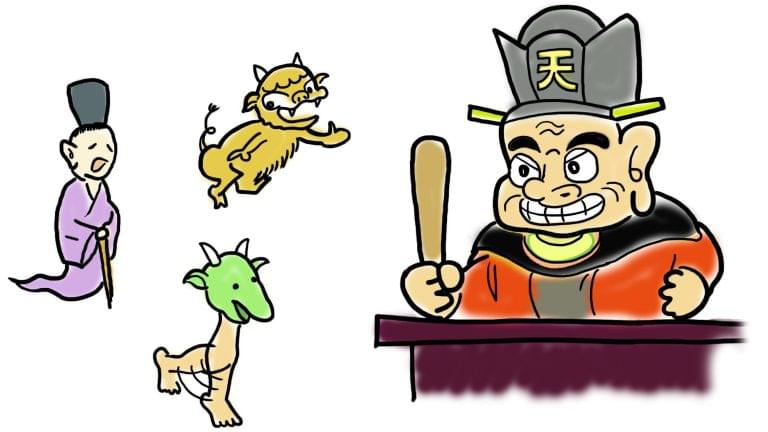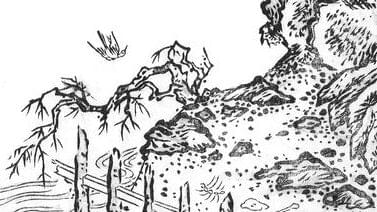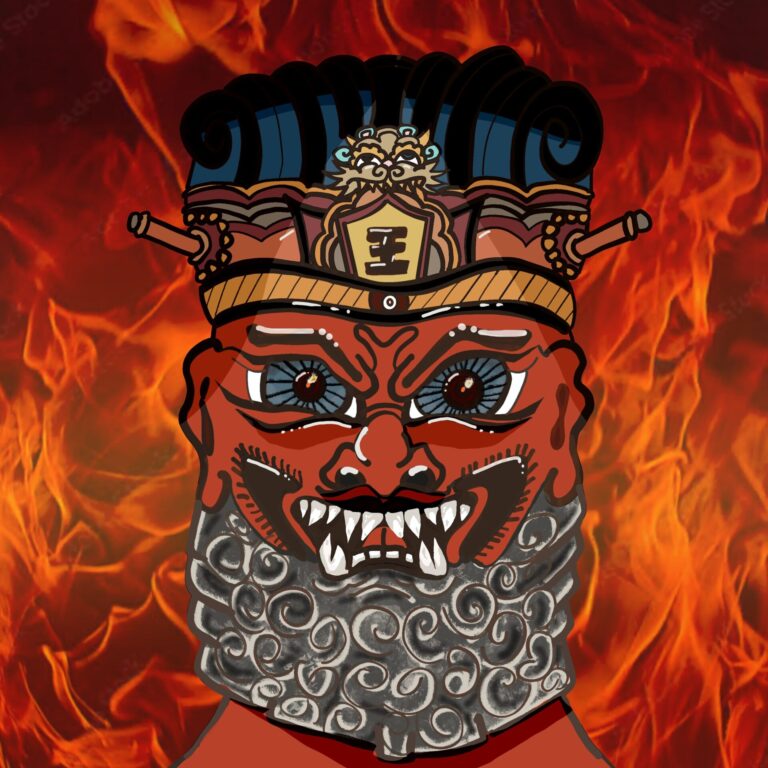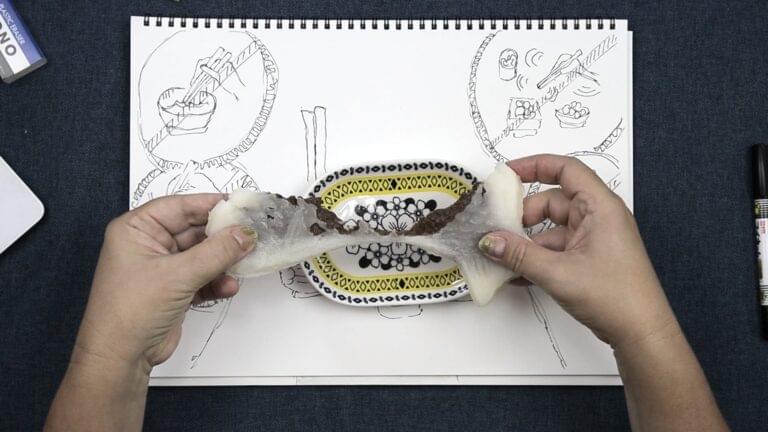Why All the Red bibs?
This is Thersa Matsuura and you’re listening to Uncanny Japan.
While strolling through the grounds of a Japanese temple or shrine you have no doubt seen the endearing sight of a statues decked out in red bibs. But why? I think I might have touched on this when I talked about ojizo statues, back in Episode 26 or 27. But that was four years ago and this is four years later and the more I read about this topic the more I realize there are a lot of different things going on here.
So today let’s look into: Why all the red bibs?
Intro
Hey hey, how are you? Getting excited about the new year coming up, 2023, the Year of the Rabbit? Yeah, me, too. What could possibly go wrong in the Year of the harmless little Bunny? What’s it going to do nibble your bum?
Thank you, Andy for the Topic
Anyway. This episode is dedicated to my patron and I hope he doesn’t mind me saying, friend, Andy.
I put up a video I made of a day trip to the Toyokawa Inari kitsune shrine over on patreon and Andy asked a seemingly straight forward question. Why are all the foxes were wearing red bibs? It’s usually something you’d see on ojizo statues…but kitsune? I couldn’t answer. I asked some Japanese friends who also thought it was a very good question and they couldn’t answer. Andy sent me a link he found and that got me started. So thank you Andy for getting me excited about a topic and also congratulations, too.
You see, he’s a Buddhist monk who after many years of study and practice, just recently received the Dharma transmission from his teacher. That means he’s the successor in an unbroken lineage of teachers. I learned from him about kechimyaku/血脈, literally blood pulse, but it means: spiritual bloodline. This means you can trace the lineage all the way back to the Big Guy himself, Siddhartha Gautama. Imagine being on that spiritual family tree. So omedetou gozaimasu, Koku-u and thank you for the nudge into the fox bib mystery. Here we go.
The Word for Bib in Japanese
Bibs. A bib, as you’d buy or make for your baby is in Japanese called a yodare-kake/よだれかっけ. Yodare is a great sounding word for “drool”. “Kake” means to hang. So a piece of cloth that hangs around one’s neck to catch drool. Because a literal translation here would be “hanging drool” or “drool hanging” and I think we can all agree that’s just gross.
Since the image of a statue drooling is also more than a little unnerving, the name for this garment as it’s used on stone or wooden figures is also different. When you’re talking about a bib on an ojizo or fox, you’d call it a maekake/前掛け. “Mae” means before or in front of, and again, “kake” to hang. But wait a minute, you say, a maekake is the Japanese word for apron. Which means…those aren’t bibs after all, they’re aprons? That does make sense. Of course there are aprons for people that go just around the waist. And ojizo (and foxes for that matter) sitting on their stone plinths don’t usually have waists. So you might want to tie the maekake a little higher around the neck perhaps to keep it secure.
Which theoretically would end this episode, because the answer to Why the Red Bibs? Is They’re not bibs, they’re aprons. Thank you for listening. Kidding. They actually are kind of they are bibs, too. And I’d be remiss if I didn’t mention that they’ve been said to be symbolic of a Buddhist monks robes, too.
What are Ojizo Again?
This is what we know. Let’s start with ojizo (again, hop back to episodes 26 and 27 for more on them). Very briefly, ojizo are those sweet-faced, kind-hearted statues you can find on temple grounds or crossroads or, well, various places. There’s one on the long version of my walk, and it’s just sitting by a river under a little shelter, not a temple or crossroad in sight. Their history is long and fascinating, but let’s remember they are the protectors of children. Especially, children or babies who have died.
These children could have died in a dozen different ways. Life was hard back then. Miscarriages, stillbirths, any number of diseases, accidents. Often children weren’t even named until their first birthday because — I was told — you didn’t want to get too attached to them. You didn’t know when they’d be called ‘home’ so to speak. So there was definitely a need to grieve for these little ones. And this tradition of ojizo helped.
The belief being that they are now on a riverbank limbo or the “sai no kawara”/賽の河原. Here they must stack stones all day long. A kind of penance, a way of getting into heaven. At night unruly and beastly oni sweep down from the mountains and knock over the stacked stones with their iron clubs. Ojizo can also swoop in, but their intention is to hide the little children under their robes and protect them from the oni or help them across the river. So you can see why parents would want to incur some favor from a local ojizo. Please help my child.
This is why you’ll sometimes find offerings to ojizo statues: toys, snacks, and pinwheels. Items a child might like. A bib then, too, being something a child would wear makes sense here.
Real Bibs to Help Find Child in the Underworld
I read in two places something that made sense to me, so I want to mention it. That before people would knit, sew, or crochet their own maekake specifically to place on a statue, the parents would use one of their own deceased child’s bibs. Maybe it was a used bib, maybe not. But it was a way for the ojizo to identify that particular child in the underworld or for the child to find comfort in this little memory of home. Dark. I know. And don’t quote me on it, I didn’t have time to read around more to see if that’s a real thing or just someone’s theory. To me it makes sense though. If a mother was sewing clothes for her unborn child and the absolute worst thing happened, in grief I could imagine her dressing a kind ojizo statue in the clothes and praying for her baby.
So we have ojizo statues being outfitted with red bibs and sometimes little red bonnets. And ojizo are of the Buddhist persuasion. But what about foxes. Foxes are found on the grounds of a jinja or Shinto shrines and they have nothing to do with going down to the sai no kawara and protecting children. As far as I know.
The Color Red
But wait, let’s talk for one moment about the color red. You’ll find it all through Japanese history. Red painted daruma dolls, red lacquered Nio guardians in front of temples, of course torii gates and shrines are more often than not bright red. When you place your inkan or seal on an important document or work of art you press it first into some sticky shuniku or vermillion paste. Red was worn by samurai as a symbol of strength in battle. Red is one of two colors on the Japanese flag and it represents the sun. Amaterasu was a sun goddess. Red.
Red was thought to have the power to get rid of disease (small pox, tuberculosis, the measles) and also for ridding us of demons, like the housou gami or god of smallpox (ep) . This might in part have come from red being associated with fire god (this is back in the 500~600s) and of course fire being used for purification rituals. Purification would protect you for both evil and illness. So red it is.
Another line of thought is that when smallpox was ravaging Japan, one’s life or death was predicted by the color of the skin. If it turned purple then the outlook was grim. If it turned red, then recovery was around the corner.
So red is connected with expelling demons and disease which easily moved into the idea of red being a healing color, one that boosted fertility and childbirth, too. It’s also auspicious and designates power.
You know that old yarn about how Eskimos have 50 words for snow? Well, let me tell you some beautiful words for red in the Japanese language that we don’t have in the West. I won’t list fifty. But here are a few that I like to give you an idea there’s:
Hinomaru no akairo=the color of red used on the Japanese flag.
Kobai-iro = plum red
Sakura-iro = cherry blossom red
Tokiha-iro = ibis wing red
Ebi-iro = shrimp red
Otome-iro = maiden red
Terigaki-iro = shiny or glazed persimon red
Mizugaki-iro = water persimmon red
Kakishibu-iro = the juice of an astringent persimmon red
There are so many more, but I’ll end with the ever romantic,
Umenezumi-iro = Plum mouse red
I could really go on and on. I think Japan’s colors for red could give those snow words a run for their money.
Anyway, just keep that in mind. While you might run across white or patterned maekake bibs, mostly they’re a beautiful bright red.
Foxes with Bibs
Back to foxes. Very often you’ll find foxes with red bibs or aprons tied around their necks as well. Foxes are the messenger for the god inari okami (that’s ookami meaning “big god”, not ookami meaning wolf). Sometimes called this god is called: Oinari. Inar-sama is the patron god of fertility, rice, tea, sake, agriculture, industry and just all around prosperity and success. Oh, and also, protector of warriors and blacksmiths. You’ve got most of your bases covered when you worship Oinari.
There are some correlations red being the color of fertility and kitsune also helping in this department. I’ve read again and again that foxes help dispel evil spirits and, of course, red is used for this. So perhaps it’s a natural step to start tying red maekaki around the necks of foxes, too.
Inari Shrines
Random fox trivia: More than a third of shrines are inari jinja. And a shrine can be an inari jinja and not have a fox statue. As a matter of fact, the one near my house is like that. It’s quite small so I guess it never had any fox statues. Although the neighborhood is taking up small monthly donations and have been for years and at some future date it’s said to get a big refurbishing. Maybe we’ll get a pair of kitsune then.
Kitsune Protecting the Kimon Gate
Also, not specifically related to bibs, but I learned that foxes are associated with the kimon, remember the north east direction that is thought to be unlucky, a place evil or oni can come storming in. You’ll can find if you’re looking, a kimon direction guarded by a fox or foxes. Indeed, the shrine I went to just recently, the well known, Toyokawa Inari Shrine, was actually a complex of several shrines and temples, but the area with the hundreds of kistune statues was situated in the back, northeast corner of the entire grounds.
Not Just Ojizo and Foxes Wear Bibs/Aprons
Some more about red bibs, sometimes you’ll find red maekake around the necks of shishi guardians, those lion dog statues that you see in the front on either side of the gate at the entrance of the jinja, shrine. Again, to dispell evil. Note: at temples you’ll find the Nio Statues, those big fierce looking warriors, that when they’re not too old are painted red.
So what I’m trying to say is there are a lot of theories, and good ones, too. And pretty much they can all be correct, depending on what point in time we’re looking at. No, I don’t think statues are adorned in red these days to stave off smallpox, but back in the day…
My Theory
My first thought when Andy asked me about the red bibs on foxes was maybe they’re placed on cute images. An ojizo, a fox, the shishi lion dogs. All cute and something that makes us want to care for it. And while that feels like right answer because I can’t remember seeing a red bib on a Buddha or Fudomyou or Kannon statue. You know higher up on the echelon of deities. They take care of us. It does seem like overwhelmingly maekake and bonnets, too, are placed on ojizo, kitsune, or shishi lion dogs, sometimes called komainu. Which are powerful and protecting and helpful, but also an entity a little closer to us humans. Something we can care for.
Which brings me to my final thoughts. A bib or apron or maekake is a simple garment to make and attach to a statue, a gesture of kindness. So my personal take away from living in Japan and trying to be observant and ask a few questions now and again, is empathy. Alongside all the reasons I just mentioned just now is also empathy. When you go outside in the dead of winter and you see a statue of an ojizo or a fox and you feel it in your gut. They must be so cold out here. Poor things. So you go home and find some extra cloth (red for good luck and fending off evil!) and you sew a maekake for the little effigy to wear and maybe you make a little hat, too, to keep its head warm, it’s just such a sweet thing to do. And others seeing it also feel something at this act of kindness. At least I do. Not know who made the garments or dressed the statue, but seeing it taken care of and respected is a very nice thing. And if there’s something we could use more of in this world, I would say acts of tenderness and compassion are high on the list.
Thank you everyone for listening to the show. One more week and we’ll wrap up 2022. Please consider becoming a patron, if you’d like. I just put up a recipe for gohei mochi, a delicious treat I had while visiting the Korankei Gorge a few weeks ago in Aichi Prefecture. I also put up a video of that and the Toyokawa Inari shrine I mentioned today. Next year I’m planning to put up more short videos of interesting and unique areas for patrons, so that will be fun.
Everyone stay safe and well and I’ll talk to you again in two weeks! Bye bye!
Credits
Intro and Outro music by Julyan Ray Matsuura
JapanSoul by Yuki Hirose
Artist website: https://original-bgm.booth.pm/items







Thank you for this explanation. I visited senso-ji today and saw many red bibs as well as a few caps
There’s is a small shrine with Tanooki and a state of a Buddha with small (tiny) children. they were all wearing red hats. I wish I could attach my picture
Hello, Mary! I love Senso-ji and so glad you could go and experience its wonder. I haven’t been in years. I’m not sure how to allow attachments either. I hope you have a wonderful time in Japan ╰(*´︶`*)╯♡